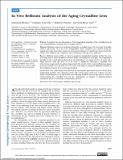In Vivo Brillouin Analysis of the Aging Crystalline Lens
Author(s)
Besner, Sebastien; Scarcelli, Giuliano; Pineda, Roberto; Yun, Seok Hyun (Andy)
DownloadBesner-2016-In Vivo Brillouin Analysis of the.pdf (1.454Mb)
PUBLISHER_CC
Publisher with Creative Commons License
Creative Commons Attribution
Terms of use
Metadata
Show full item recordAbstract
Purpose: To analyze the age dependence of the longitudinal modulus of the crystalline lens in vivo using Brillouin scattering data in healthy subjects.
Methods: Brillouin scans were performed along the crystalline lens in 56 eyes from 30 healthy subjects aged from 19 to 63 years. Longitudinal elastic modulus was acquired along the sagittal axis of the lens with a transverse and axial resolution of 4 and 60 μm, respectively. The relative lens stiffness was computed, and correlations with age were analyzed.
Results: Brillouin axial profiles revealed nonuniform longitudinal modulus within the lens, increasing from a softer periphery toward a stiffer central plateau at all ages. The longitudinal modulus at the central plateau showed no age dependence in a range of 19 to 45 years and a slight decrease with age from 45 to 63 years. A significant intersubject variability was observed in an age-matched analysis. Importantly, the extent of the central stiff plateau region increased steadily over age from 19 to 63 years. The slope of change in Brillouin modulus in the peripheral regions were nearly age-invariant.
Conclusions: The adult human lens showed no measurable age-related increase in the peak longitudinal modulus. The expansion of the stiff central region of the lens is likely to be the major contributing factor to age-related lens stiffening. Brillouin microscopy may be useful in characterizing the crystalline lens for the optimization of surgical or pharmacological treatments aimed at restoring accommodative power.
Date issued
2016-10Department
Harvard University--MIT Division of Health Sciences and TechnologyJournal
Investigative Opthalmology & Visual Science
Publisher
Association for Research in Vision and Ophthalmology
Citation
Besner, Sebastien et al. “In Vivo Brillouin Analysis of the Aging Crystalline Lens.” Investigative Opthalmology & Visual Science 57.13 (2016): 5093.
Version: Final published version
ISSN
1552-5783